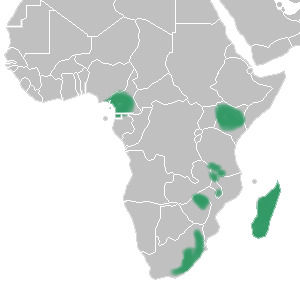Rostellum tall, erect; lateral lobes more or less lorate, concave, each with an apical viscidium; central lobe a small fleshy body at the base of the lateral lobes (except in B. coerulea, where it is finger-like); staminodes as large as or smaller than the lateral lobes.
Basal sheath(s) pale brown, up to 15 cm long, obtuse to acute, often ± mucronate; leaves 1–3(5), scattered on the scape, erect to spreading, the blade up to 22 cm long, linear to ovate, usually nitid, more or less plicate with veins somewhat prominent.
Inflorescence capitate or laxly spicate; flowers 1–numerous, c. 5–30 mm in diameter, white to mauve or pale with darker mauve spots; bracts erect, shorter than to much longer than the ovary, acuminate, green.
Dorsal sepal, c. 3–13 mm long, lanceolate, acuminate, falcate in side view, the apex often reflexed; a spur produced from dorsal sepal base, horizontal, then straight or down-curved, 0.5–5 cm long.
Petals fused by their backs to the dorsal sepal, oblanceolate, oblong or almost pandurate, occasionally with a basal anticous lobe, the upper margin flat or crenulate, the apex acute or rounded.
Anther horizontal, the apex usually up-curved; caudicles almost as long as the 2 pollen masses; viscidia 2, globular, separate.
Lip minute, erect from a broad base in front of the stigma, 0.1–2 mm long.
Lateral sepals flat, oblique, narrowly elliptic or rarely oblong, acute.
Terrestrial, rarely epiphytic or epilithic herb with perennating tubers.
Tubers more or less testicular, pubescent to woolly, up to 5 cm long.
Scape usually nitid, the base rarely sheathed in old leaf fibres.
Stigma sessile at the base of the rostellum.
Plants mostly erect, slender, 5–60 cm tall.

